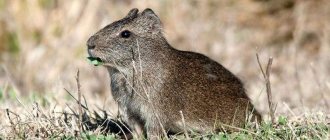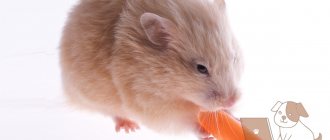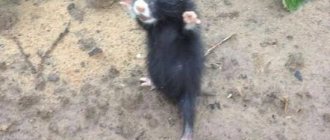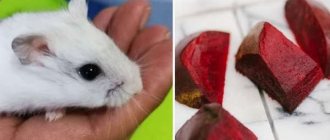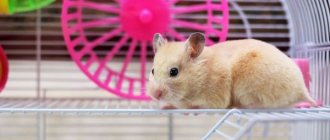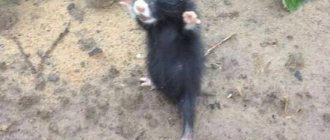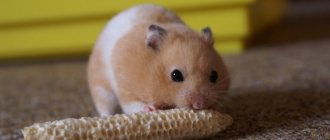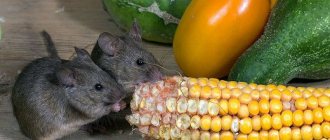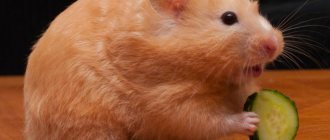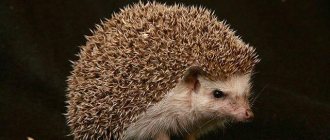The Djungarian hamster is a cute and funny animal that has become one of the most popular pets. But before you get such a pet, it is worth studying how the rodent lives in nature, where it lives, what it eats and how it reproduces.
This information will help create ideal home conditions for him. After all, if they are as similar to natural ones as possible, the hamster will feel comfortable and live longer.
History of the origin of the Djungarian hamster
Djungarians are mammals that belong to the genus of hairy-footed hamsters from the Hamster family of the order of rodents. They were first described by the researcher Waterhouse in 1839. At that time, a few individuals lived in Syria. About a century later, another scientist Aharoni from Jerusalem managed to extract a female Djungarian hamster from the hole along with a litter of 12 cubs. Most of the family died during transport to England. Then 4 hamsters remained alive.
A little time passed, and the dwarfs began to actively reproduce. First they were used for laboratory research in England, then in the USA. After about 10 years, a whole population of Djungarian hamsters was formed. Rodents have been domesticated and are now very popular among animal lovers.
Agro-industry and wild hamsters
Wild rodents feed on roots, vegetables and grains. Multiplying animals can harm the crop.
Damage to crops
A rodent that settles in a country house or garden can bring a lot of trouble to a person. The animals happily eat crops. The harvest of carrots, beets, and potatoes suffers from the invasion of pests. Animals take beans, peas, and grain from the gardens to their pantries.
Rodent control methods
Getting rid of rodents is not easy. Hamsters are careful and smart animals. Many methods have been developed to combat them. The best effect is achieved by using several methods simultaneously.
The industry produces chemicals for the extermination of rodents. First you need to find where the hamster lives. The poison is then placed near the detected pest burrows. Products designed to control rats and mice are used. The method is inhumane, but effective. Disadvantage: Poisoned bait can be accidentally eaten by pets.
Live traps and mechanical traps are actively used to catch rodents. Unlike mice, a hamster is timid and is more difficult to lure into a trap. Flooding the hole with water has a good effect. First you need to find out where the shelter is. Then you should find all the emergency exits. They must be blocked to prevent the animal from escaping. After this, they begin to pour water into the hole. After some time, the animal will leave the shelter. At this moment the rodent is easy to catch.
Getting rid of wild hamsters is very difficult.
A modern way of pest control is the use of repellers. The devices produce sounds in a frequency range that people cannot hear, but cause anxiety in animals. As a result, the animals leave the plot after some time. This is an effective and humane method. The disadvantage is the cost of purchasing expensive devices. For a large area, it may be necessary to install several repellers.
Prevention of occurrence
To prevent the appearance of rodents in your garden or dacha, it is recommended:
- do not allow waste to accumulate in the garden;
- remove root crops and vegetables to the basement or home after harvest;
- plant plants in the garden whose smell repels rodents - chamomile, mint, tansy;
- get a large cat or dog - these animals can scare away pests.
Structure and appearance
Djungarian hamsters grow to sizes of 7-10 cm in length. The weight of an adult varies between 30-65 g. Sexual dimorphism is not expressed. The animal has a pointed muzzle, beady black eyes, and small ears with rounded tips. Around the nose there are long whiskers sticking out in different directions. On the back of the body there is a tiny tail less than 1 cm long.
Djungarian hamsters in nature have an ocher-gray color. The coat is smooth. A characteristic feature of this species is a dark stripe along the back. The upper part of the body always has a darker shade than the lower part.
White or light gray fur grows in the belly area. The skin on the inside of the ears and on the paws is white. The legs are short. The fingers are covered with soft fluff.
Kinds
Domesticated Djungarian hamsters differ from their wild counterparts in the color of their coat. The most common varieties of colors:
- Standard. The cover on the back is gray-brown, the stripe is black, the belly is light gray or almost white. The paws are painted the same color.
- Pearl - in this case, the fur on all parts of the body is white.
- Sapphire. The fur on the upper part of the hamster's body is dark gray, and on the lower part it is light.
- Mandarin. The back is colored in a warm brownish-red hue, the belly is milky.
- Camel. The fur on the back and sides is cream-colored, the belly is slightly lighter.
Other popular types of colors of Djungarian hamsters are blue, dove, chocolate, lilac and champagne.
Difference from Campbell's hamster
Not so long ago, Campbell's hamsters were considered one of the varieties of dwarf hamsters. However, it turned out that these are different species. You can distinguish a dwarf hamster from a Campbell's hamster by the structure of its coat. In the first case, the cover is adjacent to the body and is smooth to the touch. In the second, the fur is stiffer and sticks out in different directions.
Description
Author: Kristina Forlovskaya
Djungarian hamsters are small animals of the hamster family, the genus Hairy-footed. The body is covered with short, light gray fur. A darker stripe runs along the back; this is how Djungarian hamsters are usually recognized.
The paws are also covered with hair, but white. In clean pets they are a pleasant white-pink color. The ears are small and round. The beady eyes are slightly protruding. The body is small. The body length of an adult dwarf is 10 cm.
Sexual characteristics
It is quite difficult to examine sexual characteristics in a pet store if you have no experience communicating with such small animals. The seller can help. He can hold the animal so that it is comfortable to watch.
If the hamster is a boy, there is a gap of 0.5 cm between the genitals and the anus and there is a formation on the tummy that resembles a navel. If it is a girl, then the gap is almost invisible, and two stripes of papillae run along the tummy.
Duration and lifestyle
In nature, Djungarian hamsters live for about 1 year. At home, where they are not in danger, life expectancy increases from 2 to 3 years.
Rodents are nocturnal. When dusk comes, they go in search of food. During the night, hamsters run about 5-10 km. During the day they return to their burrows and sleep.
Adult animals can only live alone. Each of them has their own territory that they protect. If one rodent encroaches on the property of another, a fight will occur.
Most of the life of Djungarian hamsters is spent stocking up on food. They look for grains, plant seeds, nuts, vegetables, put everything they find in their cheek pouches and carry them into the hole.
The arrangement of their homes is of particular interest. The hole, up to 3 meters deep, has several entrances and consists of separate zones that resemble compartments or rooms. They are connected to each other by a complex system of tunnels.
Each part of the burrow is designed for a specific purpose. The Djungarian hamster sleeps in one, and stores supplies in the other. The hole provides a place where the rodent goes to the toilet.
Manchurian hamsters do not hibernate during the winter. Sometimes they come out of their burrows, even when there is snow on the ground, and search for plant seeds. When the air temperature drops greatly, they fall into a state of torpor called torpor. The same thing happens to hamsters due to stress or lack of oxygen.
The coat sheds during the winter and its color becomes lighter.
Lifestyle
Adult Djungarian hamsters prefer to live alone. Unlike home conditions, in the wild the Djungarians are forced to get their own food. Therefore, these animals are characterized by constant competition for territory, food, and females. Djungarian hamsters are fearless; an adult male can attack another animal whose size is many times larger than his own.
Djungarian hamsters usually lead a twilight or nocturnal lifestyle. During daylight hours, animals rest deep underground in their burrows, and at nightfall they come out to look for something to eat.
Djungarians spend most of their short life preparing food supplies. Using subcutaneous pouches on the side of the body, hamsters drag all their supplies into the burrow so that they can eat at any time.
This type of hamster does not hibernate in winter, however, its appearance changes: if the temperature stays below 16 degrees Celsius for a long time, then the animal’s fur becomes noticeably lighter. In preparation for winter, the hamster not only stores up food for future use, but also grows fat.
A persistent decrease in temperature of 10 degrees requires large energy expenditures from hamsters, causing dwarfs to fall into torpor, reducing body temperature to 20°C (the so-called torpor phenomenon). Moreover, this condition occurs in animals not only from cold, but also from stress.
Habitat
The Djungarian hamster is native to Central Asia. It received this name in honor of the Chinese province, which is located in the northwestern part of the country. Rodents prefer to inhabit desert and steppe areas; they are less often found in forest-steppes.
The homeland of Djungarian hamsters is a relative concept, since their habitat is quite wide. This species is found in Siberia, Kazakhstan, Mongolia and some regions of China.
In Russia, these rodents inhabit the southern regions of Transbaikalia, Tuva, and some parts of Western Siberia. The species is distributed in the Chui and Aginsk steppes and in the mountainous areas of Altai.
Homeland of the Djungarians
Zoologist P. Pallas was the first to discover and describe the Djungarian hamster. This happened in 1773, when the scientist made an expedition through the territory corresponding to modern East Kazakhstan. At that time, the region was part of Dzungaria, or the Oirat Khanate.
The specific name of the animal has survived to this day. It reflects the historical name of the area where the hamster was encountered. The territory of Dzungaria in the modern sense is an area in northwestern China. Djungarians have never lived here. Their real homeland is the steppes in eastern Kazakhstan.
Sounds that the Djungarian hamster makes:
Interesting Facts
There are many interesting facts about Djungarian hamsters that make you think about the uniqueness of these animals:
- One rodent is capable of storing up to 20 kg of food - grains and vegetables.
- The volume of the cheek pouches in which hamsters carry food can be three times the size of their heads.
- Djungarians have poor eyesight and cannot distinguish colors. Their sense of smell helps them find their way home. The animals leave “fragrant” marks on stones and grass, and on the way back they find them by smell.
- One year of a hamster's life is equivalent to 25 years of a human's life.
- Djungarians cannot share their territory with relatives, but prefer to live alone. If it is encroached upon, the rodents enter into mortal combat with each other.
Unsociable friends
Djungarian hamsters have an independent character, so they are not very eager to communicate with their owners. In some cases, an agitated “fluffy” may even bite the hand that feeds him. To wean a pet from such a habit, it must be raised every day, taking it into your arms. But raising a pet once and for all will not work. If you don’t communicate with him for 7-10 days, he will become “wild” again, and you will have to start the educational process all over again.
To prevent your furry neighbor from biting, you should not take him out of the house during the daytime nap, you should not put him head down, or drive him into a corner.
Nutritional Features
Djungarian hamsters feed mainly on food of plant origin. Sometimes they eat insects - small bugs, ants. However, in most cases, the diet is dominated by plant and cereal seeds, vegetables and herbs.
Djungarians also readily eat shoots and roots of shrubs. Rough food helps them wear down their ever-growing teeth.
How to catch a wild hamster
Special live traps and traps are used to catch rodents. Structurally, they do not differ from devices for catching mice and rats. Vegetables and root crops are used for luring. The size and strength of the animals should be taken into account. The hamster is a large animal; when catching it, you must be careful and careful.
Special cages are used to catch hamsters.
Natural enemies
In natural conditions, Djungarian hamsters have many enemies. They can become victims of wild animals:
- foxes;
- ferrets;
- wolves;
- wild dogs;
- lynxes;
- marten
Birds also pose a danger to the life of Djungarian hamsters:
- hawk;
- owl;
- falcon;
- ermine.
They have good hearing, which helps them hide from enemies in time. If a Djungarian hamster hears a quiet sound coming from afar, it immediately looks for where to hide. When the source of noise is very close and the opportunity to escape is missed, the hamster freezes in place to remain unnoticed.
If this does not help, he rises on his hind legs and begins to crackle threateningly.
With the help of a loud sound that resembles a crack, hamsters warn their relatives of danger, as well as that this territory is occupied.
Care and maintenance at home
Proper care and comfortable conditions will ensure that the animal will always be active, friendly and cheerful.
Selecting a cage and filling it
The animal should be provided with sufficient freedom of movement. The cage must be at least 50x30 cm. A small space will lead to low physical activity, which can cause limb failure. You should not choose a high cage, because hamsters love to climb its walls. Falls from heights are very dangerous for a hamster.
Due to the high risk of injury, multi-story cages or complex staircase structures should be avoided.
Sawdust from fruit trees can be used as filler. Needles cannot be used because they cause allergies, lead to breathing problems and death.
You can buy corn litter at the pet store. It is considered the most convenient.
The cage can be filled with undyed paper napkins or towels, which should be torn into small pieces.
For a Djungarian hamster, it is necessary to install a wheel; its diameter should not be less than 16 cm. A small design will lead to curvature of the spine, which can cause limb failure.
You need to put a rest house in the cage. The animal will sleep in it during the day. It is not recommended to use houses with windows, because hamsters often get stuck in them.
Cotton wool, hay, fabric are hazardous materials. They must be kept away from the rodent.
Nutritional Features
Water for the animal is poured into a vacuum or ball drinker. The fluid should be changed daily. Bowls are not placed in the cage, as a wet animal may get sick.
The Djungarian hamster is prone to diabetes. For this reason, you should remove all sweet foods from your diet. The list of unsuitable foods includes carrots, apples, corn, raspberries, peach, pumpkin, etc. Potatoes, baked goods, onions, garlic, and citrus fruits should not be given.
The hamster's diet should consist of dry and wet food. It is recommended to purchase the first one ready-made at a pet store. It is better to use expensive feed, because... they are more balanced.
You can feed the animal with cucumber, lettuce, cauliflower or parsley. All leftover food must be removed immediately. To compensate for the lack of protein, the hamster should be given boiled chicken meat without spices. Outdoor insects should not be offered as they are infested with parasites.
Hamster hygiene
The rodent carries out all hygiene procedures independently. It cleans its body with its paws and tongue. To make the process easier, you can periodically place a container of sand in the cage, which is sold for guinea pigs. Hamsters love to wallow in it for a long time.
You cannot bathe an animal of this species. Water is dangerous for them.
Hamsters fulfill their natural needs in one place, where you can install a toilet for them, which will make cleaning the cage easier.
In winter, dwarfs begin to molt. Their fur becomes lighter. The process lasts 6-8 weeks.
It is important to clean the cage regularly.
Health and prevention
Suitable fresh food, conditions for physical activity, the absence of another individual in the cage, cleanliness are the main conditions for a comfortable life for dwarf hamsters.
Animals should be protected from loud sounds and screams. Even a little stress can cause the development of diseases.
You cannot place the cage high. Direct sunlight is dangerous for animals, so you should not place your pet on a windowsill or other open place.
If the hamster has become apathetic, refuses to eat, or does not move, you should not expect health to recover on its own, or self-medicate. You must immediately contact a specialist.
Reproduction and offspring
Djungarian hamsters are very fertile. Since in their natural environment they have quite a lot of enemies, nature made sure that their species did not cease to exist.
Puberty occurs at the age of 4 months. The mating season for Djungarian hamsters begins in April-May and lasts until early October. During this time, the female can bring 3-5 litters. Each litter can have 5-12 cubs.
The duration of pregnancy is 20-21 days. Djungarian hamsters are born blind, bald and deaf, but grow very quickly. After a week, their bodies are covered with soft fur, and after 10 days their eyes open. By 4 weeks of age, babies become independent and can mate.
This is interesting! The female Djungarian hamster is ready to mate with the male the next day after giving birth. However, individuals kept at home are not recommended to be mated frequently. Pregnancy takes a lot of energy and depletes the female’s body. She needs time to recover.
Knowledge about Djungarian hamsters will help the owner of the animal to best arrange his home and organize food at home. This will allow the rodent to remain healthy and please its owner for a long time.
Habitats and distribution area
Finding out in which zone the hamster lives is useful for understanding the characteristics of the pet’s life. Although domestic varieties differ in their habits from their wild relatives, similarities exist between them.
Hamsters in the wild inhabit all continents, with the exception of Australia and Antarctica. Favorite habitat is open steppe landscapes. Rodents prefer to settle in warm, dry places, close to a food source. Some species live in close proximity to humans.
Steppe individuals
Many species of hamsters inhabit steppe and forest-steppe regions. They are common in the south of the Russian Federation, China, and Central Asia. The animals live in Eastern Kazakhstan and Western Siberia. The most numerous species of steppe rodents is the dzhungarika. They are well studied and described by scientists. Djungarian hamsters are popular as pets.
Steppe individuals are common in the south of the Russian Federation.
In the wild, the main enemies of steppe rodents are foxes, weasels, and wolves. Birds of prey hunt hamsters - owls, eagles, falcons.
For shelter, the animals dig deep holes in the ground.
Forest hamsters
In North America, there are species that prefer to settle in rocks, under stones and fallen trees. Locals call the rodents tree rats. Animals often set up their shelters not far from humans. This makes them easy prey for dogs and cats.
Field varieties
The distribution range of field rodents in the wild stretches from Southern Europe to the northeastern part of China. This type of animal is often called karbysh. These are quite large animals. The plowing of meadows for agricultural land and active deforestation are reducing their habitat. Field species begin to settle near humans. When numbers increase, rodents can harm the crop.
Field varieties of hamsters are large in size.
Interesting facts about the life of hamsters in nature
Hamsters are funny animals. While observing the animals, people learned many interesting facts about their life and habits:
- animals are able to swim well by taking air into their cheek pouches;
- in winter, rodents periodically wake up to eat food stored in the pantry;
- hamsters prefer to live in dry, well-warmed places by the sun;
- peak activity occurs at night;
- in Vietnam there is a law prohibiting the keeping and breeding of animals at home to prevent the spread of infectious diseases;
- they protect their territory from their relatives and do not hesitate to rush into a fight when other individuals invade;
- Rodents have very poor eyesight, they are nearsighted and unable to distinguish colors;
- Hamsters have excellent hearing, which helps them avoid danger.
The hamster is an unusual and interesting animal. Despite their close relationship with domestic pets, wild individuals differ from them in lifestyle, size and character.
How can you get infected from a wild hamster bite?
Wild rodents are natural carriers of many diseases. The bite of the animal is dangerous for humans and domestic animals. The rodent's teeth are sharp and leave deep, poorly healing wounds. The saliva of animals contains pathogens of about 30 diseases.
Fleas live in fur and carry salmonella, tularemia, brucella and other infections.
If you are bitten by a wild hamster, you should rinse the wound thoroughly with running water. Then treat the skin with disinfectants - hydrogen peroxide or iodine. Sometimes after a bite the victim’s body temperature rises. To avoid serious consequences, it is recommended to seek qualified help at a medical center or hospital as soon as possible.
